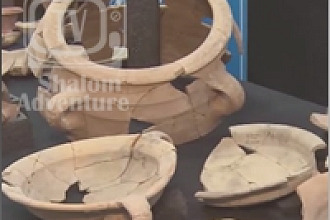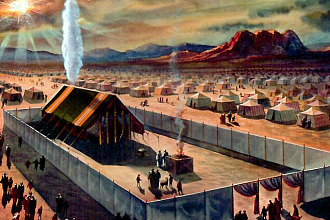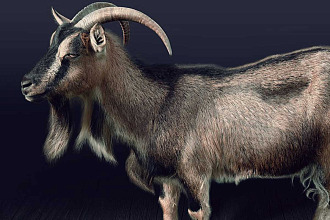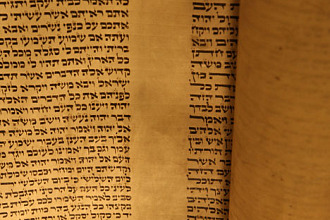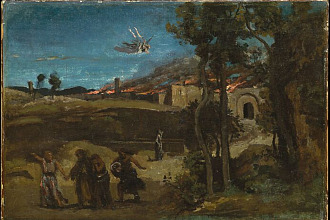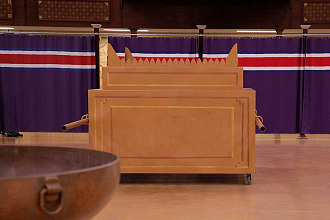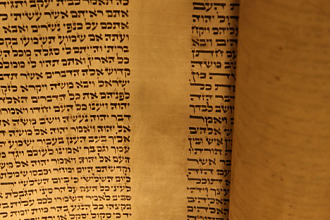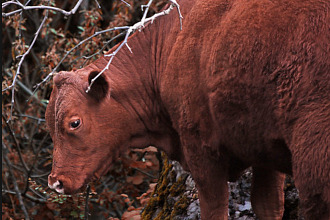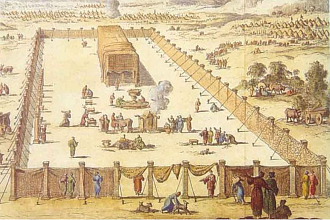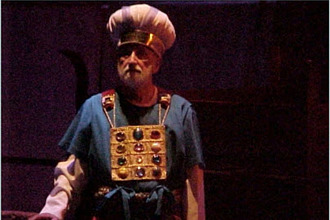Parasha for the Week: Vayakhel - Pukidey: Exodus 35:1 – 40:38
Haftarah for the Week: 1 Kings 7:13 - 8:21
Apostolic Writings: Matthew 24
Overview:
Vayakhel: Moshe Rabbeinu exhorts Bnei Yisrael (children of Israel) to keep Shabbat, and requests donations for the materials for making the Mishkan (sanctuary).
He collects gold, silver, precious stones, skins and yarn, as well as incense and olive oil for the menorah and for anointing.
The princes of each tribe bring the precious stones for the Kohen Gadol’s breastplate and ephod.
G-d appoints Betzalel and Oholiav as the master craftsmen.
Bnei Yisrael contribute so much that Moshe begins to refuse donations.
Special curtains with two different covers were designed for the Mishkan’s roof and door.
Gold-covered boards in silver bases were connected, forming the Mishkan’s walls.
Betzalel made the Holy Ark (which contained the Tablets) from wood covered with gold.
On the Ark’s cover were two figures facing each other.
The menorah and the table with the showbreads were also of gold.
Two altars were made: a small incense altar of wood overlaid with gold, and a larger altar for sacrifices made of wood covered with copper.
Pikudey: The Book of Shemot concludes with this Parasha. After finishing all the different parts, vessels and garments used in the Mishkan, Moshe gives a complete accounting and enumeration of all the contributions and of the various clothing and vessels which had been fashioned. Bnei Yisrael bring everything to Moshe.
He inspects the handiwork and notes that everything was made according to G-d’s specifications.
Moshe blesses the people. G-d speaks to Moshe and tells him that the Mishkan should be set up on the first day of the first month, (Nissan). He also tells Moshe the order of assembly for the Mishkan and its vessels. Moshe does everything in the prescribed manner.
When the Mishkan is finally complete with every vessel in its place, a cloud descends upon it, indicating that G-d’s glory was resting there. Whenever the cloud moved away from the Mishkan, Bnei Yisrael would follow it. At night the cloud was replaced by a pillar of fire..
“A Special Gathering”
The gathering of the kehillah is the first topic of our parashah, that is why the title is Vayakhel. The Jewish tradition has understood this gathering of Vayakhel as a unique opportunity for Moshe under the divine inspiration to point out the necessity of unification of the people of Israel, even though they were divided in twelve tribes. Now they are united all together to listen to the recommendation and Mitsvoth G-d wants to give them. We mustn’t forget that the world of 3500 years ago was not united as today, there were a lot of tribal wars and conflict between cities, thus, the unity of the tribes of Israel, in a divided world had be a strong testimony.
This parashah is pointing out the command of G-d to build and erect the Dwelling Place which was requested to Moses from the chapter 25, but now, after the golden calf under the impact of a completely new experience.
Through this experience the people and the Kohanim had come to realize, even after the experience of the Mount Sinai, how weak and they still were, and how much they still were influence by the Egyptian culture and how much they needed to work on themselves to get victory on these weakness, and to realize that without this G-d who gave them freedom from the bondage of Egypt, they were nothing, thus, that were in need of being uplifted and atonement for what they have done, but also and maybe for what they are.
Moreover, they had come to know G-d in all the severity of His judgment, but also in all the fullness of His grace. They had experienced all the nuances of their relationship with G-d, from the feeling of utter rejection by G-d up to the heights of Divine favor regained
Rabbi Hirsch draws from these texts that: these events recorded in the last chapters of Exodus for all time, between the order to build the Sanctuary and the actual execution of the command became documentary proof that it is possible at any stage of error to repent and to regain G-d’s grace.
And he added a very important thought: “The greatest national crime was committed, and the highest grace was attained from G-d — without Sanctuary and without offerings, If any more proof were needed that the Sanctuary and the offering in themselves do not secure G-d’s favor, but are intended only as guides to the attainment of G-d’s grace.” (Hirsch 2006)
Everyone who has accepted Yeshua as the Messiah agrees with this affirmation, because the offerings or sacrifices had no power or special value as sacrifices, they were there in the Sanctuary only for the purpose to point out to Mashiach and to teach about the coming of Mashiach and how G-d is giving his favor forever to everyone who accept his will.
“The New Moon”
The Mishkan, (Sanctuary) was established on the first day of the first month, Nissan that means the first day of the Jewish year. As the Jewish calendar is a lunar calendar, it was the new moon. “The L-rd spoke to Moses, saying, “On the first day of the first month you shall erect the tabernacle of the tent of meeting.” (Exodus 40:1–2), Rabbi Hirsch says that this apparent redundancy is understood if we remember the significance of the new moons in Judaism. The new moon is not a holiday marking a cosmic astronomical event; rather, through the natural phenomenon, it presents Israelites with a model and exhorts them to establish and observe new moons, renewals, in human society, in their own lives.
Rabbi Hirsch says about the establishment of the Sanctuary on that day: “Upon the establishment of the Dwelling place of the Tent of Appointed Meeting.” G-d’s glory will begin to dwell on earth in the midst of the people of Israel, and thereby will begin Israel’s Moed (appointed meeting), the conjunction of Israel with its “Sun,” its illumination by the light of G-d. This will take place on the day of the first new moon, on the day of that new moon which is the beginning of the Jewish year. This was the new moon, which [in Egypt] first brought to Israel the message of constant renewal. Through Israel, the mes-sage was to be conveyed to all of mankind.
The new moon of the arising of the nation was also the new moon of the dwelling of the Shechinah, the fulfillment of the promise “I will dwell among them”, by which G-d wanted to illustrate the complete redemption of Israel through the Messiah, who is the complete fulfillment of the Sanctuary.
Haftarah: 1 Kings 7:13 – 59
The text of the Haftarah is in parallel with the text of the Parashah and tells us how about four hundred eighty years after Betzalel, Solomon choose a Jew living in Tyre, Hiram, for his artistic talent with copper. He brought him to Jerusalem to achieve some of the work of the Temple: “King Solomon sent for Hiram and brought him down from Tyre. He was the son of a widow of the tribe of Naphtali, and his father had been a Tyrian, a coppersmith. He was endowed with skill, ability, and talent for executing all work in bronze. He came to King Solomon and executed all his work.” (1Kings 7:13-14). The Tanach helps us to identify this man, because in his time the king of Tyre was also called Hiram, we know that this king Hiram was very cooperative with Solomon and helped him to get the woods and stones he needed. This artisan was not king Hiram, but a Jew from the tribe of Naphtali, but according to the parallel text in the second book of Chronicles 2:14 he was from Dan, thus the rabbis have concluded that his father was from the tribe of Naphtali and his mother from the tribe of Dan. His father is called a Tyrian, just because he was living in Tyre. Abarbanel suggests that since his mother was a widow, Hiram was living in Tyre to comfort and support her.
The Parasha and the Haftarah made some interesting parallel because the tow construction, Between the sanctuary built by Moses and the temple built by Solomon. Moses choose Betzalel from the tribe of Judah and Oholiab from the tribe of Dan (Exodus 31:2, 6) and the Temple in Jerusalem was built by Solomon who was from the tribe of Judah with the help of Hiram from the tribe of Dan. The Midrash (Shemot Rabbah 40) said about these two tribes that the most exalted tribe was the tribe of Judah and the one the lest respected was the tribe of Dan (by the way this tribe is not listed in the list of the 12 tribes of the 144,000 in Revelation 7, it is also an indication of its spiritual failure). However, G-d asked these two tribes to collaborate together to build the sanctuary and the Temple, even though the tribe of Dan has fallen in apostasy G-d wishes unity among his people; the most exalted tribe has to collaborate and to work with the less respected tribes of Israel.
The text said about Hiram that he was “filled with wisdom, understanding and skill to do any work in bronze” (1 Kings 7:14) the Jewish tradition affirmed that he had the same qualifications and qualities of Bezalel who built the sanctuary with Moses, and Rashi defines his qualities in this way: “Wisdom is the knowledge one acquires from others; insight refers to the new ideas and deductions that one derives from analyzing and developing his prior wisdom; and knowledge in the context of building the Tabernacle, is Divine inspiration” (Scherman 2006, 69). It is interesting that Jews in this text translate the Divine inspiration as the Ruach Hakodesh, it is exactly the same idea we have in the Apostolic Writings were Rabbi Shaul says “All Scripture [The Tanach] is inspired by G-d and useful for teaching, for reproof, for restoration, and for training in righteousness” (2 Timothy 3:16), the Bible has been inspired by this divine inspiration which is the Ruach Hakodesh. And Shim’on-Peter is more precise when he affirms, “Above all understand this: no prophecy of Scripture comes about from a person’s own interpretation. For no prophecy was ever brought forth by human will; rather, people spoke from G-d as they were moved by the Ruach ha-Kodesh” (2 Peter 1:20–21). The Ruach Hakodesh, has worked on earth, inspiring prophets, but also distributing spiritual gifts to everyone who is ready to serve Hashem, it was Betzalel, Oholiab and thousands of others..
Apostolic Writings: Matthew 24
This chapter 24 of Matthew. We are here at the very end of the minister of Yeshua. His last days are spent in Jerusalem while Pesach is coming soon. Since the beginning of his public ministry Yeshua Hamashiach spent all the feasts of Pesach in Jerusalem, let’s remember here that Yeshua was a practicing Jew. He did not neglected the laws which were given from the mount Sinai, he was himself there. According to the Torah Pesach was one of these pilgrimage feasts (Pesach, Shavuot, Sukkoth). Thus, it was important for Yeshua to be present in Jerusalem for each of these feasts.
Just before this event of the chapter 24, Yeshua had some difficult time and discussion with the pharisees and the leaders of Israel. Then he needed some rest and took the direction of Bethany, his home, when he stayed in Jerusalem, it was the house of Myriam, Martha and Lazarus. Bethany was on the other side of the Mount of Olive, that is why Yeshua and his talmidim had to pass through the Mount of Olive. The first verse of Matthew 24 states: “Now when Yeshua went out and was going away from the Temple, His disciples came up to point out to Him the Temple buildings.” (Matthew 24:1). We know that the Temple was a cluster of impressive buildings. The building of the Second Temple started after the deportation of Babylon, but it was a modest building, as the sanctuary of the wilderness was a modest tent, but progressively and particularly on the first century before Yeshua, this temple was almost rebuilt in a beautiful way under the supervision of Herod the Great. Now everyone can appreciate this magnificent construction. Yeshua’s talmidim were simple Galilean people, they were not used to great building, in Capernaum, Tabgha or even Tiberias, the city built in honor of Tiber Cesar were no impressive building. They never traveled, they never went to Rome, Ephesus or Athens, thus Jerusalem was for them the great city, and this temple was real something big and beautiful. That is why the text says that they “point out to Him the Temple buildings” They were villagers coming to the big city. What a disappointment when they heard Yeshua’s answer: “‘Don’t you see all these?’” He responded to them. ‘Amen, I tell you, not one stone will be left here on top of another—every one will be torn down!’” (Matthew 24:2), he start his answer by the word “amen” this word is here to say that what he is going to say is the truth. Amen is a word which has the same root of Emunah, faith, faithful, today we would say in Hebrew BeEmet, that means in Truth, “I tell you” there is no doubt about the word of Yeshua. The talmidim have followed Yeshua until this point because they have witnesses that Yeshua was a true prophet. If they were not sure at this point that he was the Mashiach, they were sure that he was a prophet sent by G-d to reveal to Israel the will of G-d for this time of the end. Yes, they had this conviction they were at the end of time. How it was possible that this great building could be destroyed. While they were continuing their walk, they were thinking about these words of Yeshua, how it is possible that this building could be destroyed? They arrived at a spot were they had a nice view of the city of Jerusalem, which was not so large as today, and the text precises that they set down to look at the city: “As He was sitting on the Mount of Olives,” Thus the talmidim came closed to him: “the disciples came to Him privately, saying, ‘Tell us, when will these things happen? What will be the sign of Your coming and of the end of the age?’” (Matthew 24:3). Three questions are here, Yeshua announced the destruction of the city, they have no doubt, they are sure that the word of Yeshua will be true, they did not say to him “Are you sure?” “How this will happen?” No, their first question is “When will there things happen?” We understand this question, if a prophet appear today in your town and tell you that your city will be destroyed very soon, then the first question you would have would be “When?” It was the same, they would prefer not to be in Jerusalem at that time. The second question is about the second coming of Yeshua, “What will be the sign of Your coming?” This second question is not from the talmidim, it is a question which is inspire by the Ruach Hakodesh, yes they pronounced it, but they did not about what they were speaking. Yeshua was still among them, Yeshua will die only a few days later, he will then resurrect, and will reveal to them that he is going back to heaven and one day he will come back. But at this moment they did not know exactly what would be their future. Let remember that we are before the last Seder of Passover, at the last Seder Yeshua will reveal to them that his ministry was not yet to establish the kingdom of G-d, he had to go back to heaven and then he will come back: Do not let your heart be troubled. Trust in G-d; trust also in Me. In My Father’s house there are many dwelling places. If it were not so, would I have told you that I am going to prepare a place for you? If I go and prepare a place for you, I will come again and take you to Myself, so that where I am you may also be. And you know the way to where I am going. (John 14:1–4)
The reaction of Thomas is clear: “Rav, we don’t know where You are going.” (John 14:5). They did not know, the future, they did not know that Yeshua would die on the next day. That is why we can consider that the question asked in Matthew 24, was an important question not really for them, but for us, for the future generations. That is why today we are sure that it is time, were are at the end, Mashiach is coming back. Not only us, Believers in Yeshua are convinced that Yeshua is coming soon, but Jews are convinced about this too. Of course there are group of Jews as the Conservative, reform or liberal who don’t believe anymore in a personal Mashiach, but all the traditional and Orthodox Jews still believe in a personal Mashiach who is coming soon. And all these groups who believe in a personal Messiah believe that we are, right now at the time of the coming of Mashiach. Today, therefore, the big question is not to know if he is coming for the first or the second time, as Martin Buber says it when he was at a meeting of dialogue and friendship between Jews and Christians, when the Messiah he will ask him: ‘do you come for the first or the second time’ but he will speak slowly at his hear, “please don’t answer.” This question has divided Jews and Christians for centuries, but when Mashiach will come back this question will not be important, the most important point will be, will we be ready for this coming? Yes, or Not? He went to heaven to prepare a space for us in the house of his father, are we ready to go to meet him on the air, because that will be the way we will meet him when he will come back: “For the Lord Himself shall come down from heaven with a commanding shout, with the voice of the archangel and with the blast of G-d’s shofar, and the dead in Messiah shall rise first. Then we who are alive, who are left behind, will be caught up together with them in the clouds, to meet the Lord in the air—and so we shall always be with the Lord. Therefore encourage one another with these words.” (1 Thes. 4:13–18).



